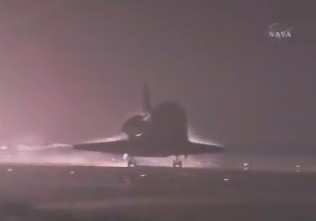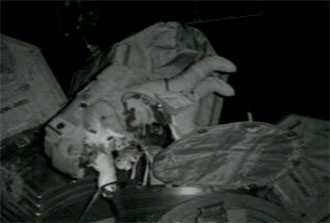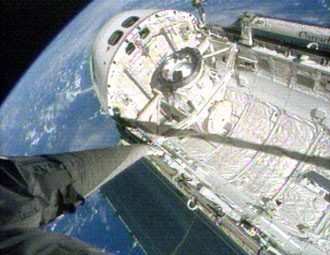 ANN REALTIME REPORTING
09.21.06 0621 EDT: -- A mission that saw its fair share of
drama -- be it related to suspect bolts, suspect weather, suspect sensors, or suspect debris -- came to a safe end
moments ago at Kennedy Space Center, as the shuttle Atlantis rolled
to a stop on Runway 33 in a spectacular early-morning landing.
ANN REALTIME REPORTING
09.21.06 0621 EDT: -- A mission that saw its fair share of
drama -- be it related to suspect bolts, suspect weather, suspect sensors, or suspect debris -- came to a safe end
moments ago at Kennedy Space Center, as the shuttle Atlantis rolled
to a stop on Runway 33 in a spectacular early-morning landing.
STS-115 Commander Brent Jett and Pilot Chris Ferguson fired
Space Shuttle Atlantis' engines at 5:14 am EDT, beginning the
descent to Kennedy Space Center.
It appeared to be a picture-perfect landing. After landing,
Atlantis Commander Brent Jett told Mission Control at NASA's
Johnson Space Center, "Thanks, Houston. It's nice to be back. It
was a great team effort, so I think assembly's off to a good
start."
The flight was the first in a series of missions that will be
among the most complex in space history. Atlantis delivered the
first major new component to the station since 2002 and laid the
groundwork for upcoming station assembly missions.
Mission Accomplishments
STS-115 is one of the most photographed shuttle missions ever,
with more than 100 high-definition, digital, video and film cameras
documenting the launch and climb to orbit. Data from these images,
as well as station and shuttle crew inspection, helped to clear
Atlantis' thermal protection system for return only two and a half
days after launch.

Tanner, Piper, Burbank and MacLean, with the help of crewmates,
made three spacewalks that completed truss installation, enabled
solar arrays to be deployed and prepared an important radiator for
later activation. They also installed a signal processor and
transponder that transmits voice and data to the ground and
performed other tasks to upgrade and protect the station's
systems.
A new procedure called a "camp out" was implemented, in which
astronauts slept in the Quest airlock prior to their spacewalks.
The process shortens the "prebreathe" time during which nitrogen is
purged from the astronauts' systems and air pressure is lowered so
the spacewalkers avoid the condition known as the bends. On each of
the three spacewalks, the astronauts were able to perform more than
the number of scheduled activities.
The astronauts performed unprecedented robotics work. They used
the shuttle's arm in a delicate maneuver to hand off the school
bus-sized truss to the station's arm. The 45-foot truss weighs
35,000 pounds.
The arrays at the end of the truss extended to their full
240-foot wingspan once they unfurled on flight day six. The
astronauts also moved the station's robotic arm to a position where
it will assist in the next phase of station construction.
After Atlantis undocked from the station, it did the first full
fly-around of the facility since prior to the Space Shuttle
Columbia accident. The maneuver helped ground crews get a better
perspective on the station's environment and overall exterior
health.
After undocking, the Atlantis crew participated in a first-ever
three-way call with the Expedition 13 crew aboard the International
Space Station and the three crew members of the Soyuz spacecraft on
its way to the station. All 12 astronauts in space at that time
were able to have a conversation.

With Atlantis and its crew safely home, the stage is set for the
next stage of International Space Station assembly. Preparations
continue for Space Shuttle Discovery's launch, targeted for
mid-December, on the STS-116 mission to deliver an additional truss
segment and a cargo module to the station. Discovery will also do
extensive work on the station's electrical and cooling systems.
 NTSB Final Report: Cozy Cub
NTSB Final Report: Cozy Cub ANN FAQ: Contributing To Aero-TV
ANN FAQ: Contributing To Aero-TV Classic Aero-TV: Seated On The Edge Of Forever -- A PPC's Bird's Eye View
Classic Aero-TV: Seated On The Edge Of Forever -- A PPC's Bird's Eye View ANN's Daily Aero-Linx (04.29.25)
ANN's Daily Aero-Linx (04.29.25) ANN's Daily Aero-Term (04.29.25): Execute Missed Approach
ANN's Daily Aero-Term (04.29.25): Execute Missed Approach





